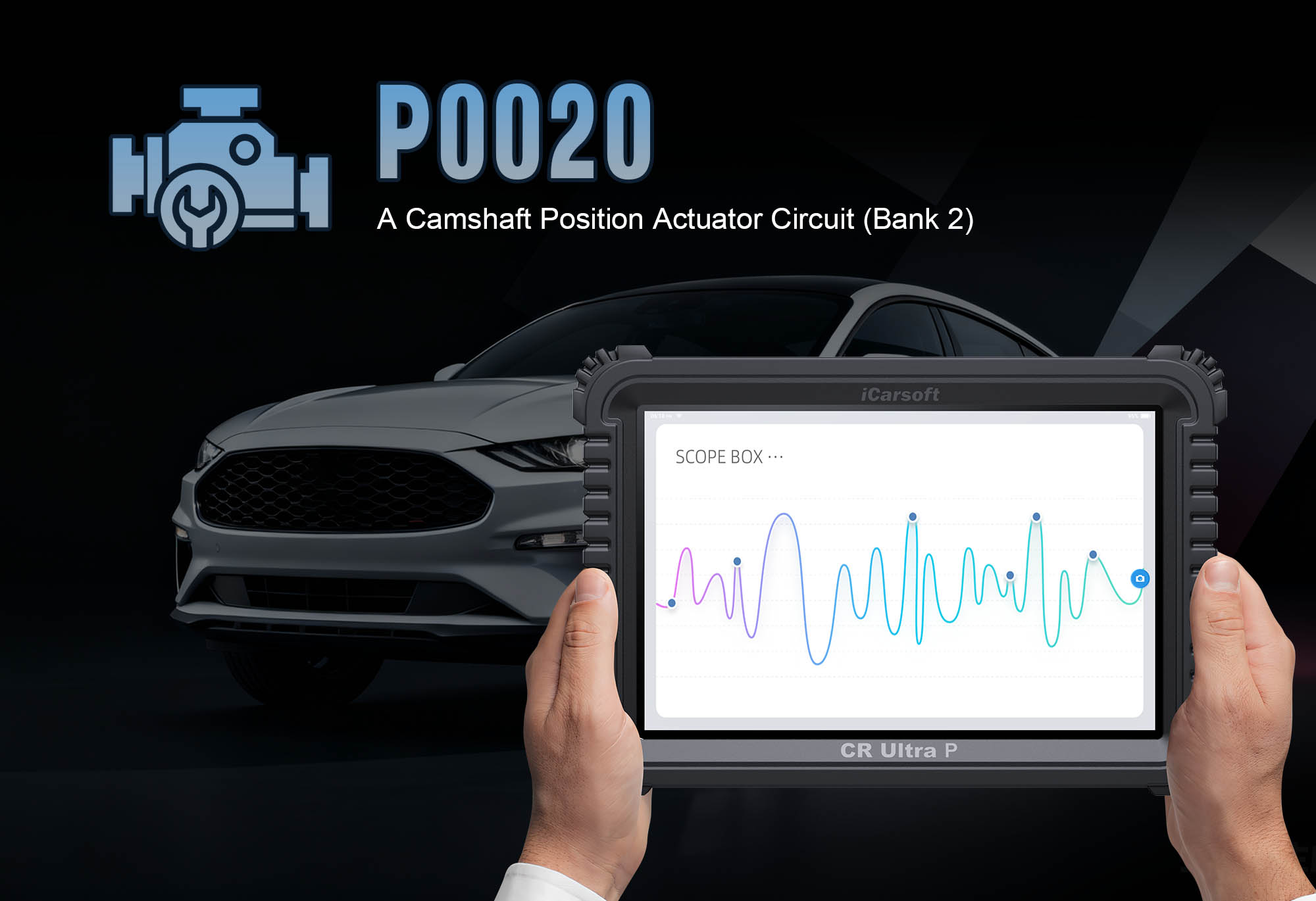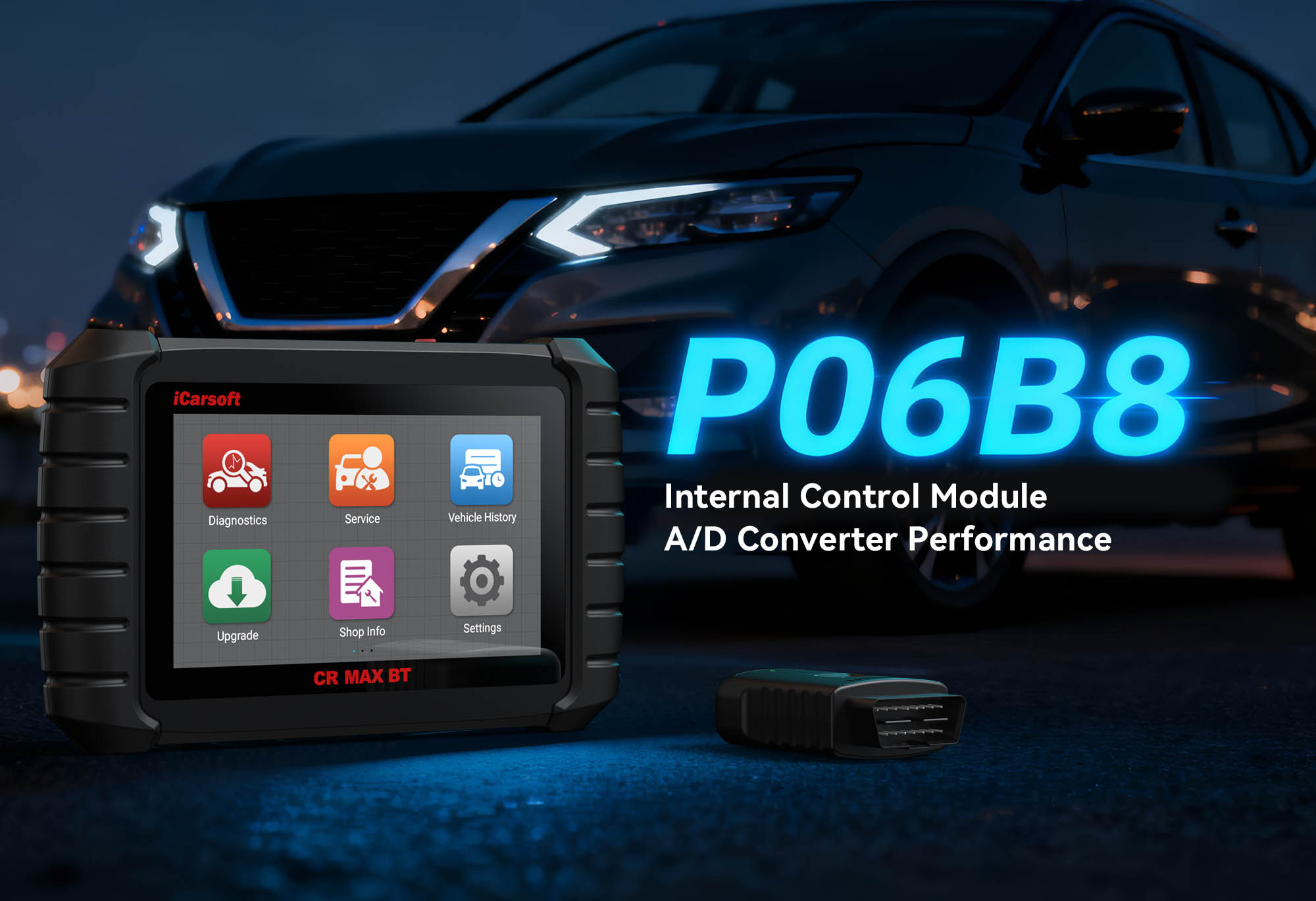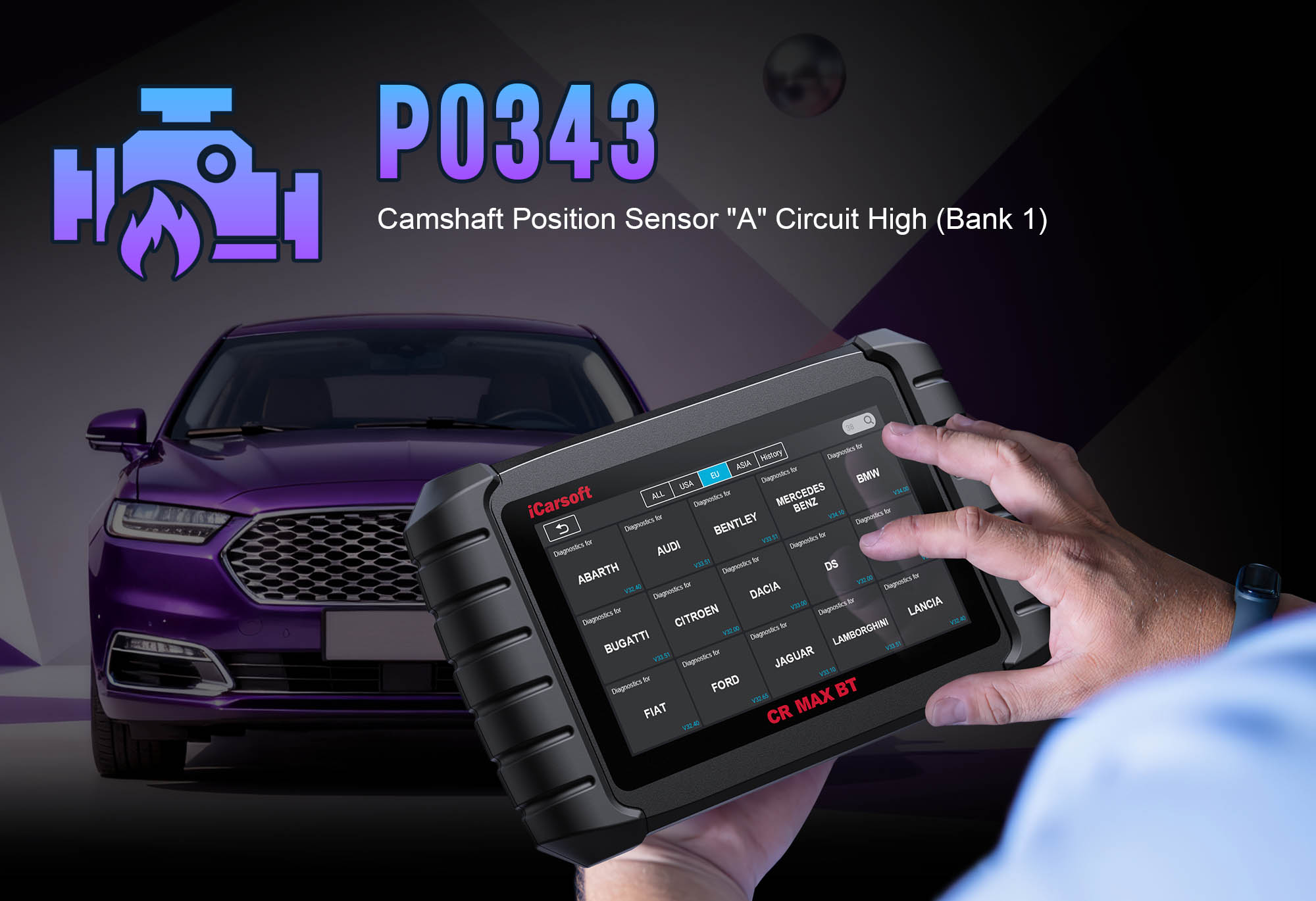Understand & Fix P0020: Intake Valve Timing Control Solenoid Circuit (Bank 2) with iCarsoft CR Pro S
If your vehicle’s check engine light illuminates, you notice rough idling, reduced acceleration, or poor fuel economy, a diagnostic scan will likely return P0020. This OBD-II code stands for "Intake Valve Timing Control Solenoid Circuit (Bank 2)"—a critical fault targeting the variable valve timing (VVT) solenoid on the second cylinder bank. The VVT solenoid regulates oil flow to the camshaft phaser, adjusting valve timing for optimal engine performance at different speeds. When the solenoid’s circuit malfunctions (e.g., open, shorted, or unresponsive), the Engine Control Module (ECM) can’t control valve timing, disrupting combustion efficiency.
Basic scanners might only flag a "VVT solenoid error" but can’t test solenoid responsiveness, verify oil flow, or check circuit integrity—leaving you guessing between a faulty solenoid, clogged oil passages, or wiring issues. The iCarsoft CR Pro S, with its OE-level engine diagnostics, bi-directional control, and live data tracking, solves this. Below, we break down P0020, its causes, symptoms, step-by-step resolution, and 8 FAQs to answer common troubleshooting questions.
What Is P0020?
P0020 focuses on the intake VVT solenoid circuit for Bank 2 (Bank 2 refers to the cylinder bank opposite the number 1 cylinder—check your vehicle’s manual for specific cylinder numbering). The VVT solenoid is an electrically controlled valve that directs engine oil to the camshaft phaser, which adjusts camshaft position. The ECM sends a voltage signal (typically 12V) to activate the solenoid; a "circuit malfunction" means the ECM detects irregular voltage, no current flow, or unresponsive solenoid operation. This prevents proper valve timing adjustment, leading to performance and efficiency issues.
Key Symptoms of P0020
-
Illuminated Check Engine Light: The primary warning sign, often paired with codes like P0010 (Bank 1 intake VVT solenoid circuit) or P0018 (Bank 2 exhaust VVT solenoid circuit).
-
Rough Idling & Misfires: Incorrect valve timing disrupts combustion at low speeds, causing engine shaking.
-
Reduced Acceleration & Power: Restricted valve timing limits airflow and fuel efficiency, especially at high RPM.
-
Poor Fuel Economy: Inefficient combustion increases fuel consumption by 10–15%.
-
Engine Hesitation: Delayed response when pressing the gas pedal due to mismatched valve and piston timing.
-
Cold Start Issues: Harder cranking or prolonged warm-up as the VVT system fails to optimize timing for cold conditions.
Common Causes of P0020
|
Cause
|
Description
|
|
Faulty Intake VVT Solenoid (Bank 2)
|
Worn internal components (e.g., valve stuck open/closed) or electrical failure in the solenoid.
|
|
Clogged Oil Passages
|
Sludge or debris blocks oil flow to the solenoid or camshaft phaser, preventing operation.
|
|
Wiring/Circuit Issues
|
Frayed wires, corroded connectors, or loose terminals disrupting signal/voltage to the solenoid.
|
|
Low/Contaminated Engine Oil
|
Insufficient oil pressure or degraded oil (old/dirty) impairs VVT system function.
|
|
Failed Camshaft Phaser
|
A stuck or worn phaser (the component the solenoid controls) mimics solenoid circuit issues.
|
|
ECM Malfunction
|
Rarely, the ECM’s internal driver for the solenoid circuit fails to send proper signals.
|
Why iCarsoft CR Pro S Excels at Diagnosing P0020
The CR Pro S outperforms basic tools with features tailored to VVT system and circuit diagnostics:
Bi-Directional Solenoid Testing
Sends activation signals to Bank 2 intake VVT solenoid to verify responsiveness—distinguishes solenoid faults from wiring issues.
Live Circuit Voltage Tracking
Monitors solenoid circuit voltage in real time, highlighting irregularities (e.g., 0V when activated = open circuit).
Oil Pressure & Temperature Monitoring
Checks oil pressure (where supported) to rule out low-pressure-related VVT failures.
Global Vehicle Coverage
Supports 50+ major brands with VVT systems, including luxury and performance models.
40+ Hot Service Functions
Includes VVT system reset, oil service reset, and camshaft position calibration—critical for post-repair validation.
Component Location Tool
Pinpoints Bank 2 intake VVT solenoid and related wiring for quick access.
Step-by-Step: Diagnose P0020 with iCarsoft CR Pro S
-
Confirm P0020 & Gather Data
Plug the CR Pro S into your vehicle’s OBD-II port, power on the tool, and select AutoVIN Identify to auto-detect make, model, and cylinder bank configuration.
Navigate to Engine > Fault Codes > Read Codes to confirm P0020. Tap Code Details for model-specific insights (e.g., "Toyota Camry: Bank 2 Intake VVT Solenoid Circuit Malfunction; Voltage: 0V, Expected: 12V; Check Solenoid or Wiring").
-
Analyze Live VVT System Data
Go to Engine > Live Data > VVT & Camshaft and monitor three key metrics:
1. Bank 2 Intake VVT Solenoid Voltage: Switches between 0V (deactivated) and 12V (activated) per ECM commands. Fixed voltage = circuit fault.
2. Camshaft Position Sensor Data: Mismatched camshaft/crankshaft timing confirms VVT system failure.
3. Engine Oil Temperature: Optimal 180–220°F (82–104°C)—overheating/cold oil impairs VVT function.
-
Test the VVT Solenoid & Circuit
1. Use Bi-Directional Control > Engine > VVT Solenoid Test: Send activation commands to Bank 2 intake solenoid. Listen for clicking and check voltage adjustment. No response = faulty solenoid.
2. Locate the solenoid: Use the CR Pro S’s Component Location tool (typically on cylinder head near camshaft).
3. Inspect & Test: Check for oil leaks, damage, or debris. Use the CR Pro S’s Resistance Test (match OEM specs, e.g., 10–30 ohms—open/infinite resistance = faulty solenoid).
-
Inspect Wiring, Oil, & Camshaft Phaser
1. Wiring Check: Use Continuity Test on solenoid wiring for breaks/shorts. Look for damage near heat sources or moving parts.
2. Oil Check: Verify level and condition (clear amber = good; dark/viscous = contaminated). Perform oil change if needed, and use Oil Reset to reset maintenance intervals.
3. Phaser Check: Remove solenoid to inspect oil passages for clogging. Use Camshaft Position Calibration to reset stuck phaser (severe cases require replacement).
-
Repair & Clear the Code
- Replace Bank 2 intake VVT solenoid if faulty. Clean clogged oil passages with engine flush or repair damaged wiring.
- Refill with OEM-specified engine oil and reset the ECM with the CR Pro S.
- Use the CR Pro S to Clear Codes and run VVT System Validation Test. Test drive to ensure smooth idle, acceleration, and normal fuel economy.
FAQs: P0020 Troubleshooting
Can I drive with P0020?
Short trips are possible, but prolonged driving worsens VVT system damage and reduces fuel efficiency. Avoid highway driving and diagnose with the CR Pro S immediately.
How much does it cost to fix P0020?
A new VVT solenoid costs $50–$200, plus $80–$150 for labor. Oil change/flushing adds $100–$200. Camshaft phaser replacement costs $500–$1,200. The CR Pro S saves on diagnostic fees ($100–$200).
Why does P0020 keep returning after clearing it?
The root cause wasn’t fixed. Common culprits: unaddressed oil contamination, hidden wiring damage, or a faulty camshaft phaser. Use the CR Pro S’s History Log to track recurrence.
What’s the difference between P0020 (Bank 2) and P0010 (Bank 1)?
P0020 targets the Bank 2 intake VVT solenoid, while P0010 affects Bank 1. The CR Pro S’s cylinder bank identification tool distinguishes these faults.
How do I distinguish between a faulty solenoid and low oil pressure?
Compare live data: Solenoid doesn’t respond + normal oil pressure = faulty solenoid; Solenoid responds + low oil pressure = oil system issue (e.g., clogged passages, oil pump failure).
Do I need to reset the ECM after replacing the VVT solenoid?
Yes—use the CR Pro S’s ECM Reset function to clear old adaptive data and sync the new solenoid with the VVT system.
Can old engine oil cause P0020?
Yes—dirty oil clogs solenoid passages or reduces pressure. Use the CR Pro S’s Oil Life Monitor to check oil condition.
Will P0020 affect emissions?
Yes—incorrect valve timing increases harmful emissions (HC, CO) and may cause an emissions test failure. Fix P0020 with the CR Pro S to ensure compliance.
Conclusion
P0020’s VVT solenoid circuit fault disrupts engine performance and efficiency, but the iCarsoft CR Pro S simplifies diagnosis with bi-directional testing, live voltage tracking, and VVT system calibration. It ensures you fix the root cause—whether it’s a faulty solenoid, clogged oil passages, or wiring issues—instead of just clearing the code.
With a 5-inch touchscreen, lifetime free updates, and coverage for 50+ brands, the CR Pro S is a must-have for DIYers and mechanics. Resolve P0020, restore optimal valve timing, and avoid costly engine damage—all with one professional-grade diagnostic scanner.





